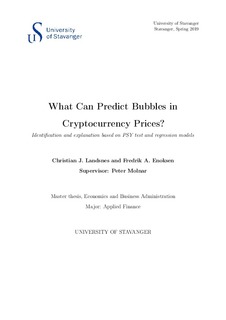What Can Predict Bubbles in Cryptocurrency Prices?
Master thesis
Submitted version

Åpne
Permanent lenke
http://hdl.handle.net/11250/2616646Utgivelsesdato
2019-06Metadata
Vis full innførselSamlinger
- Studentoppgaver (Business) [1023]
Sammendrag
In this paper we study variables that can predict bubbles in cryptocurrency prices. Bubble periods are detected by employing a recursive augmented Dickey-Fuller algorithm called the PSY test, developed by \citet{phillips2015testing-a,phillips2015testing-b}. Through probit and linear regression models we study the possible predictors of the bubble periods. We utilize both detected days and the underlying test statistics produced by the algorithm as dependent variables in the analysis. Compared to other studies, we emphasize uncertainty measures as predictors and include an extended selection of cryptocurrencies. We apply panel regressions to investigate predictors across cryptocurrencies and time series regressions to study predictors for specific cryptocurrencies. We detect multiple bubble periods in all cryptocurrencies, particularly in 2017 and early 2018. The predictive ability of the variables appear to be depedent on the cryptocurrency studied. Though in general, we find that higher volatility and trading volume is positively associated with the presence of bubbles across cryptocurrencies. When it comes to uncertainty variables, the VIX-index consistently demonstrates negative relationships with bubble behavior. Furthermore, transactions and the EPU-index mostly exhibit positive associations with bubbles, but the effects are dependent on the cryptocurrency examined. In terms of bubble prediction, the probit models perform better than the linear models.
Beskrivelse
Master's thesis in Applied Finance
